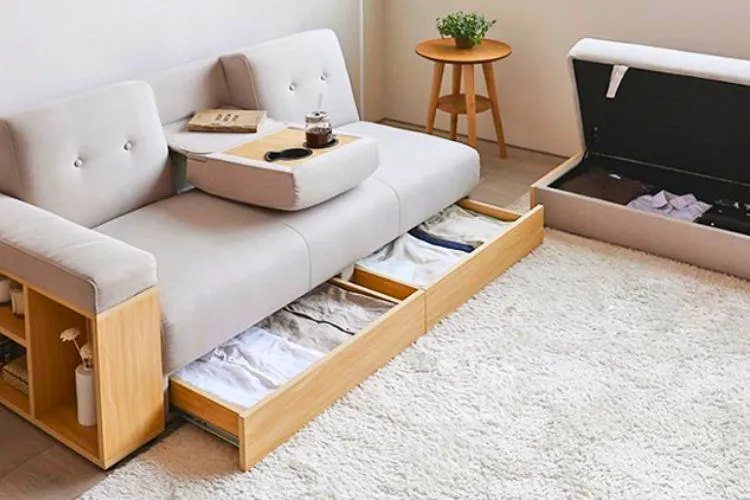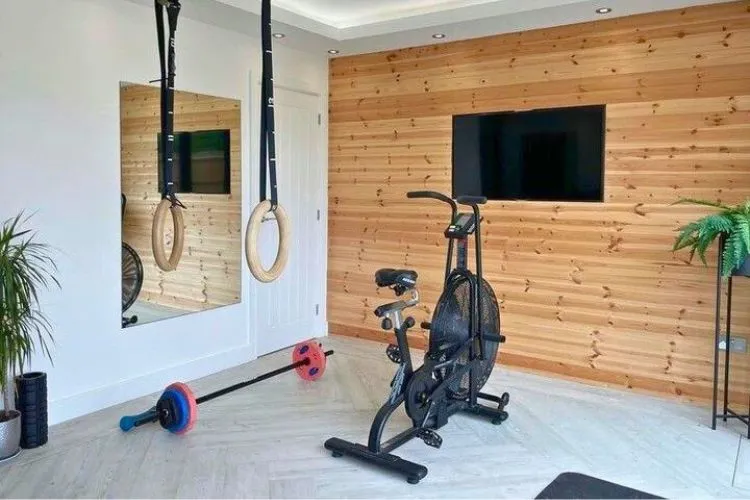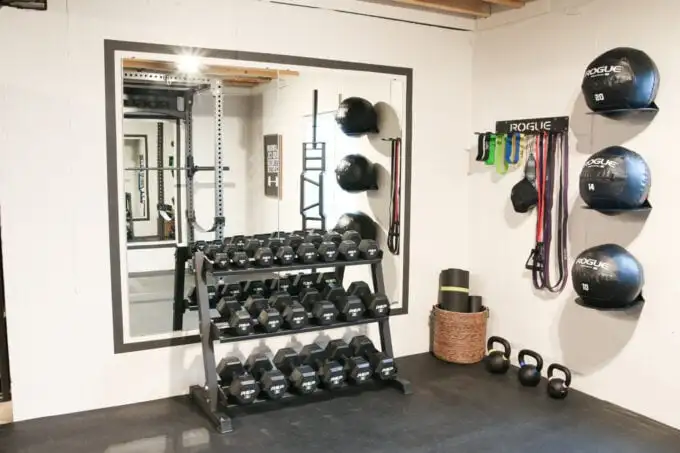The surge in home workouts has necessitated the integration of exercise equipment into our living spaces.
However, the challenge arises when this equipment needs to coexist with the decor in the most communal part of the home: the living room.
This article aims to guide you through the process of how to hide exercise equipment in your living room, ensuring your living space remains both functional and aesthetically pleasing.

Understanding the Challenge
Introducing exercise equipment into a living room isn’t as straightforward as it might seem. From bulky treadmills to sets of weights, each piece can disrupt the room’s harmony and flow. The aesthetic clash between sleek, modern decor and utilitarian fitness gear is a common issue.
Moreover, for those residing in apartments or homes with limited space, the challenge intensifies, making efficient use of space paramount.
Planning and Preparation
The first step involves a thorough assessment of your living room’s layout and available space. Identify which pieces of equipment are non-negotiables for your fitness routine and which can be stored away or even downsized.
Establishing a budget for any necessary purchases, such as storage solutions or multi-purpose furniture, is also crucial at this stage.
How To Hide Exercise Equipment In Your Living Room?
Multi-Functional Furniture
The market is replete with furniture designed to serve dual purposes—storage and aesthetics. Ottomans with hidden compartments, benches that open up to reveal storage space, and coffee tables featuring drawers are excellent for stowing away smaller fitness items.

These pieces should harmonize with your room’s existing decor to maintain a cohesive look. Ventilation within these storage units is a consideration not to be overlooked, especially for storing items like sneakers or yoga mats that may retain moisture.
Decorative Screens and Room Dividers
For those who prefer not to mix their workout area with their relaxation space, decorative screens and room dividers offer an elegant solution.
They can seamlessly section off a part of the living room, concealing exercise equipment without sacrificing style. The key is to select a divider that enhances the room’s overall aesthetic.
Vertical Storage
Making use of vertical space by installing wall mounts for bicycles, resistance bands, and yoga mats can drastically reduce clutter. These mounts can be chosen for their design as much as their functionality, blending into the wall or adding to the room’s decor when the equipment is in use.
Camouflage with Decor
Sometimes, the best way to hide something is in plain sight. By strategically placing plants, using room decor to your advantage, or arranging furniture thoughtfully, you can obscure exercise equipment effectively. This tactic requires a keen eye for design and can often result in a fun, creative challenge.
Behind-the-Scenes Storage
For equipment that can’t be easily integrated into your living room’s decor, look to closets, spaces under the sofa, or even custom-built solutions. Custom storage can be particularly effective, as it allows for the maximization of otherwise underutilized spaces, ensuring that every square inch serves a purpose.
Design-Themed Equipment
The fitness industry has responded to the demand for more aesthetically pleasing equipment, offering options that can easily blend into or even enhance a living room’s design.
Whether it’s a vintage-style stationary bike or sleek, minimalist weights, selecting equipment that aligns with your decor theme can negate the need for concealment.
Artistic Displays
For those who view their fitness equipment as a point of pride, there’s the option to display it as art. Wall-mounted racks for yoga mats or weights can serve as a modern art installation, turning functional items into conversation pieces.
Maximizing Vertical Space for Exercise Storage
In the quest to seamlessly blend fitness into our living environments, especially in homes where space is at a premium, the creative use of vertical space emerges as a game-changing strategy.

This approach not only helps in decluttering valuable floor space but also in keeping exercise equipment organized and accessible. Let’s delve into the techniques and tools that can transform your walls into efficient storage solutions for your fitness gear, along with examples to inspire your setup.
Techniques for Utilizing Vertical Space
- Assess Your Equipment: Begin by taking stock of your exercise equipment. Identify items that are suitable for vertical storage, such as yoga mats, resistance bands, dumbbells, and even foldable bikes. This assessment will guide the selection of appropriate storage solutions.
- Plan Your Space: Consider the layout of your room and identify walls or unused spaces behind doors that could be utilized for equipment storage. Planning involves balancing accessibility with aesthetics, ensuring that the equipment does not interfere with the room’s functionality or design.
- Choose the Right Mounting Solutions: The market offers a variety of wall-mounted systems designed for specific types of exercise equipment. Selecting the right mounting hardware is crucial for safety and efficiency. Ensure that the chosen solutions are capable of supporting the weight and dimensions of your equipment.
- Prioritize Accessibility and Safety: Arrange your equipment in a manner that keeps frequently used items within easy reach, while less frequently used gear can be stored higher up. Always consider safety, ensuring that heavier items are mounted securely and at a safe height to prevent injuries.
Tools for Vertical Storage

- Wall-Mounted Racks: These are ideal for hanging weights, kettlebells, and even barbells. Look for racks with adjustable hooks to accommodate different sizes and shapes of equipment.
- Hooks and Pegs: Simple yet versatile, hooks and pegs can be used to hang resistance bands, jump ropes, and yoga straps. They can be easily rearranged as your collection of equipment evolves.
- Shelves: Sturdy wall-mounted shelves can serve as a platform for smaller items like dumbbells, yoga blocks, and foam rollers. Adjustable shelving units offer flexibility, allowing you to customize the storage space according to your needs.
- Cabinet Systems: For a more concealed storage solution, wall-mounted cabinets can hide away equipment while keeping it organized. This option is particularly appealing for those looking to maintain a minimalist aesthetic in their living space.
Examples of Vertical Storage Solutions
- Yoga Mat Storage: A wall-mounted rack with adjustable arms can elegantly display multiple yoga mats while allowing them to air out and stay rolled up neatly.
- Resistance Bands and Jump Ropes: Individual hooks or a pegboard system can be used to hang resistance bands and jump ropes, making them easily accessible while avoiding tangles.
- Weights and Dumbbells: A custom rack or a set of sturdy shelves can be designed to hold a range of weights and dumbbells, keeping them off the floor and organized by size.
- Foldable Equipment: For items like foldable bicycles or collapsible treadmills, wall-mounted hooks or brackets can secure them against the wall, freeing up floor space when they’re not in use.
- Multi-Use Gym Systems: Some wall-mounted systems are designed to support a variety of equipment, including pull-up bars, suspension training straps, and even heavy punching bags, offering a complete workout station that occupies minimal space.
By implementing these techniques and tools, you can transform your living space into an efficient area that accommodates both your fitness lifestyle and your aesthetic preferences. Maximizing vertical space not only enhances the functionality of your home but also contributes to a more organized and motivating environment for your workouts.
Frequently Asked Questions (FAQs)
How can I hide my treadmill in my living room?
Consider a foldable treadmill that can be stored vertically against a wall or behind a sofa. A decorative screen can also be used to conceal it when not in use.
Are there any stylish exercise equipment options that don’t need hiding?
Yes, many brands now offer beautifully designed exercise equipment that can double as decor. Look for items that match your living room’s style.
How can I motivate myself to use equipment that is stored out of sight?
Create a routine that includes setting up your equipment at a specific time each day, making it a ritual. Keeping a workout log visible can also serve as a reminder and motivator.
Conclusion:
The key to successfully integrating exercise equipment into your living room lies in balance. By carefully planning and selecting the right storage solutions, you can maintain the aesthetic appeal of your living space without sacrificing your fitness goals.
Remember, the goal is not just to hide your equipment but to seamlessly incorporate it into your home in a way that complements your lifestyle.


